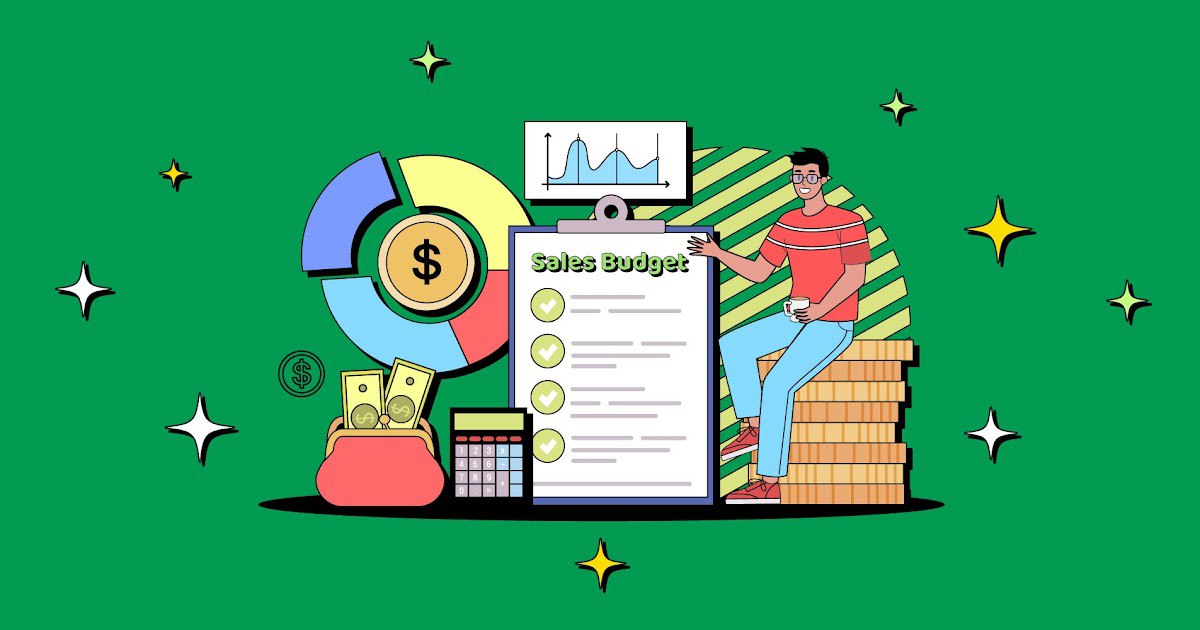
What is a Sales Budget and How to Make One!
A sales budget is one of many budgets that you as a manager have to use for effective resource management and strategy development. Every part of a business needs a tightly managed budget. Be it marketing, outreach, or sales. You need a certain level of objectivity to effectively manage each aspect of your business. A well-planned budget comes in super handy for making the tough decisions you’ll have to make as a manager.
So when it’s time to make decisions about your business’s sales targets and strategies it’s crucial to have a sales budget on hand. In this article, we’re going to check out why sales budgets are important, how sales budgeting works, building a sales budget, and the best practices for a proper sales budget.
What is a sales budget?
A sales budget is like a plan for how much a company thinks it’ll sell in a fixed amount of time. The budget shows how many of each product or service the company expects to sell and how much money it will make in return.
If a company has a lot of different products, it might group them together into bigger categories to make it easier to plan. A sales budget forms the basis of further budgets such as materials and labor budgets. It also feeds into the managerial and executive expense estimates.
In reality, estimates from marketing, sales, customer service, and management all come into play in building an actionable and accurate sales budget.
But the sales budget is much more important than just that. Here’s why,
Why is a sales budget important?
There are quite a few reasons to develop a sales budget, including,
Setting goals
The first thing a sales budget tells you is your goal for the given period of time. It could be a month, a quarter, or a whole year. The idea is to create a budget that reflects your goals for that time period. The more factors your budget takes into account the more achievable the goals will become.
Identifying opportunities and issues
A sales budget helps provide a framework for strategy development. So when your sales (or marketing) strategy doesn’t perform as expected, it’s easier to find the problems and address them in real time. Similarly, it’s easier to identify opportunities for strategies that perform well.
Financial planning
The point of any budget is to simplify financial planning. A sales budget does that for almost every business. As the sales budget feeds into other estimations it’s a crucial part of financial planning for your business. After all, your goals are sales, and anything you spend should feed into the sales growth. A sales budget helps you make these estimates and plan accordingly. These estimates include profitability analysis, calculating customer support costs, and lifetime value of customers as well.
Benchmark
A sales budget is built on your estimate of sales. So it provides a trackable reference for your sales performance. If your sales team is reaching the goals perfectly your estimates are correct and your strategies are working to make them a reality. Similarly, if the team is failing to meet the quotas then you may have overestimated and need to reevaluate your strategies.
All in all a sales budget gives you the benchmark for tracking your real-time sales performance.
Sales budget: What you’ll need?
A sales budget requires information and data from multiple departments the most important of them being,
Sales forecast
The sales forecast tells you the number of units you can expect to sell in a given time. Usually, the marketing team generates these estimates, and can also be called marketing forecasts too. The forecast tells you exactly how much you can expect to sell based on trends. It also sets the reference point for creating strategies that will increase the projections.
Price per unit
Along with knowing how much you’ll sell, you’ll need to know how much you’ll make from it. This data usually comes from the unit price for products or services you’ll sell. Some companies choose to use unit prices for individual products while others create product clusters and manage the sales budget according to that.
Total revenue
The total revenue is the total amount that you’ll generate from achieving the sales goal. This data comes from multiplying the unit cost with the total estimated sales. In usual cases, the total revenue is the primary goal that needs to be tracked throughout the sales period.
Sales period
The sales period is the timespan the sales budget is for. If you’re estimating monthly sales then the budget is a monthly sales budget. Similarly, if you calculate quarterly or annual sales the budget turns into quarterly and annual sales budgets respectively.
Beginning balance
Carryover from the previous cycle or year. This number comes directly from the accounts team and signifies the amount to be paid from the last cycle but is paid in the current cycle. This provides a continuity of the whole sales budget across cycles.
Be where your customers are!
Hear your customers wherever they need you.
Creating a sales budget
Now that we’ve got everything we need to create the sales budget let’s get to the task and see what you need to do.
Determine time span
The first thing you’ll need to define is the period of time the sales budget is going to work with. Time frames will change all the assumptions you’ll make, so it’s crucial to keep the period significant but not too broad. Companies usually create quarterly and annual budgets so that’s the time span they use. You can go for a monthly budget as well.
Inventory
Next up you’ll need to know exactly how much of your product is available for sale. This should also include the pricing and manufacturing cost of your inventory. For businesses dealing in physical goods, this is fairly simple. For service companies and digital products, the inventory needs to provide the highest number of clients you can manage with the existing system without expanding anything.
Analyze historical data
A sales budget is a well-informed estimate. A key part of making this estimate is having data from the previous sales cycles. This data lets you build projections for future sales quotas and budgeting requirements.
Factor trends and current events
The next part of your estimate depends on the current events and trends. A good example is the semiconductor shortage that occurred right after the pandemic. During the pandemic sales of cars and other smart devices went up. Based on those sales companies projected a large number of sales in the post-pandemic year. However, the semiconductor producers were unable to meet the inflated demands.
Come the following year the sales went down because the pandemic buying spree stopped. Now device and car manufacturers were stuck with too many products and no means of finishing the product without semiconductors and no customers to sell them to either. Reading ahead of trends is a crucial part of creating an accurate sales budget.
Creating the sales budget: Example
Now we can go ahead and create a sales budget for a hypothetical company. The budgets will be quarterly and annual budgets for the company.
A sales budget for the 2nd quarter from March to May

A sales budget for the year

Get The Sales Budget Template
Get your hands on our simple sales budget template in Google Sheet format and calculate a sales budget for your business!
Sales budget: Best practices
So we’ve covered how you can build a sales budget from scratch. Keep the following best practices in mind to make sure your sales budget is as accurate as possible:
- Clearly state your goals, such as raising sales, income, or client base. Use SMART goals to keep them effective.
- List the important actions that will enable you to accomplish these goals.
- Estimate the costs precisely so that you can meet your planned sales budget.
- Regularly coordinate and communicate with the administration, production, sales, and marketing departments.
- Monitor Timing decisions so you can maintain accuracy regardless of unforeseen constraints
What are the limitations of sales budgets?
While sales budgets provide a ton of utility there are some limitations to creating sales budgets too. The first challenge is time and effort. The sales budgeting process is time-consuming and requires significant effort to be actionable.
The second limitation is the fact that it’s based on predictions and estimates, making accuracy a huge challenge.
On top of that, reaching a consensus about the budget is a challenge in and of itself. Different people may have different opinions on the budget, which can make it difficult to get everyone on board with it.
Lastly, for new companies, it can be particularly hard to prepare a sales budget because they don’t have past sales levels and trends to use as a guide.
Wrapping up
That’s all you really need to know to get started with your sales budget for 2023. The years just started and you can still plan up for the 3 upcoming quarters. Using this model you can create a sales budget for any business regardless of scale.
You need to ensure the estimates and goals are based on reality and not on blind assumptions. Keep crushing those goals and see your estimated budget turn into reality.
Until next time, happy serving!
Your own Support Portal in 5 minutes!
Start off with a powerful ticketing system that delivers smooth collaboration with unlimited room for your customers.












Leave a Reply